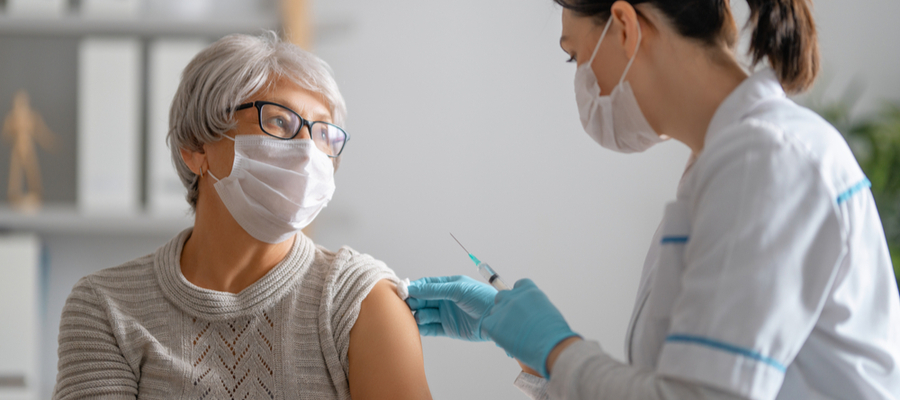We’ve all been waiting for good news about vaccinations, and now it’s finally here. The wait has been more arduous for some than others. Older adults are particularly hard hit by the pandemic, both those living in their own homes who are self-isolating, and more so for those living in long-term care facilities. Fingers crossed, before long, each one of us will be vaccinated; Canadians young and old will be able to return to their pre-pandemic lives. We’ll be able to hug our grandchildren, possibly dine in restaurants and maybe even enjoy a visit to the hair salon.
During a televised press conference on March 9, two days short of an entire year, when the WHO identified Covid-19 as a pandemic, Prime Minister Justin Trudeau informed the nation that by the end of March 2021, Canada would receive 8-million more vaccines. “Our top priority is to get you your vaccine,” he affirmed. “We have reasons to remain positive.” This means Canada will have access to a total of eight- million vaccine doses from Pfizer, Moderna, and AstraZeneca by the end of the first quarter, up from an original commitment of six million doses.
Trudeau also announced that March 11, 2021 is devoted to a nation-wide observance to commemorate those lost to the pandemic. 22,736 Canadians have died due to COVID. As Chief Public Health Officer of Canada, Dr. Theresa Tam said during the press conference, “it is a time to reflect on the cherished lives we have lost –and the world-wide research effort to produce multiple safe and effective vaccines. We have adapted, and we have endured, and I know we have what it takes to get through this difficult time.”
The good news is that Pfizer is also accelerating shipments for April and May by one million additional doses each month. By the end of the second quarter, Canada is on track to receive 36.5 million doses, and by the end of the third quarter, 117.9 million, which will include the now-approved Johnson & Johnson vaccine.
On the same day as this federal government press conference, the Toronto Star presented its vaccine gap tracker, which tracks the gap between the number of vaccines Ontario is administering every day and what it needs to be administering to meet the stated goals of retired General Rick Hillier, head of Ontario’s COVID-19 Vaccine Distribution Task Force.
If Ontario is to give 75% of its population at least one dose by June 20, it will have to vaccinate, on average, approximately 97,000 new people per day between March 6 and June 20, according to the Star’s vaccine tracker. This informative graphic tracks the province’s current average number of first vaccination doses per day against that goal. “The longer daily first doses given stay below the 97,000 average goal, the higher they will have to be later to hit that target.
“For this tool, the Star is making the conservative assumption that 75 per cent of the population of Ontario will receive one dose of the vaccine by the stated goal; this is to account for the fact that children are not currently approved to receive the vaccine and that some adults will not be vaccinated due to hesitancy or medical reasons.”
In Ontario, according to the Star, “this translates to the need to give at least 97,000 new people a first dose every day starting March 6 to ensure 75 per cent of the province’s population receives a dose by June 20, the first day of summer. This calculation takes into account the roughly 619,000 Ontarians who have received at least one dose before March 6.”
Right now, the best way to find out when you can register for your vaccine is to search your regional health unit online. For me, that is Halton Region in Ontario, and I can see from its website when I am eligible to receive my first vaccine (between April and the end of June), when and how I can register online for an appointment or find the phone number I can call if I’m unable to access the Internet. If all goes well, if vaccine delivery remains on track, and if regional health units can keep up with the demand, I should be able to receive a vaccine by June 20. Each regional health unit is different so make sure to check the one where you live. You can find information on the Ontario vaccine plan and information on how to get vaccinated in Toronto.
Currently, Ontario is completing Phase 1 of the vaccine rollout plan, reserved for high-risk populations, including adults over 80 years old.
Phase 2, running from April 2021 to July 2021, is designated for adults aged 60 to 79 –in five-year increments. It includes individuals with high-risk chronic conditions and their caregivers. The Ontario website indicates that the distribution of vaccines will be available at mass vaccination clinics and at pharmacies, primary care clinics, mobile units, and public health clinics during Phase 2.
From July onward, throughout the province of Ontario, the general population will be eligible for vaccinations at various locations such as mass vaccination clinics, pharmacies and primary health clinics.
Being fully vaccinated comes about two weeks after receiving the second dose of Pfizer or Moderna or two weeks after one dose of Johnson & Johnson. In the U.S., the CDC issued new guidelines advising that the fully vaccinated can mingle in small groups with others of low risk. Masks should be worn, and distancing should be practiced with high-risk people. These guidelines are not applicable for Canada.
However, the Huffington Post was careful to recommend caution when following post-vaccination guidelines:
“Before we grade the safety of various post-vaccination activities, it’s worth noting a few important caveats. One, you want to look at community transmission. If cases are extremely high in your area, certain activities (like dining indoors) will be way riskier compared to an area with minimal COVID-19 activity. Second, you still have to evaluate your personal risk. We should all continue to wear masks and maintain physical distancing. If you have underlying health conditions that make you more vulnerable to COVID-19 or if you live with someone who does, it’ll be vital to continue practicing the tried-and-true safety precautions. Keep in mind that about 1 in 20 people won’t be protected even after getting vaccinated.”
My final word of caution is to avoid scams. Yes, there are unscrupulous people out there preying on vulnerable Canadians who are desperate to be vaccinated. The city of Hamilton issued a warning that there’s a phone scam in the city where residents are told they can jump the line for a price. Similarly, in Alberta, residents 75 years and older are offered queue jumping for a price. So far, more than 13,500 COVID-19 scams are reported. Global News stresses that these are the red flags to look out for:
- Aggressive behaviour and sense of urgency by the caller.
- Suggestion of severe consequences if you don’t agree to the caller’s terms.
- Specific demand for payment.
If a scammer targets you, you are encouraged to file a report with your local police department.
In the meantime, while we wait for our turn to be vaccinated, try to be optimistic. By the end of June, most Canadians 60 years and older will have had at least one shot in the arm.
 |































